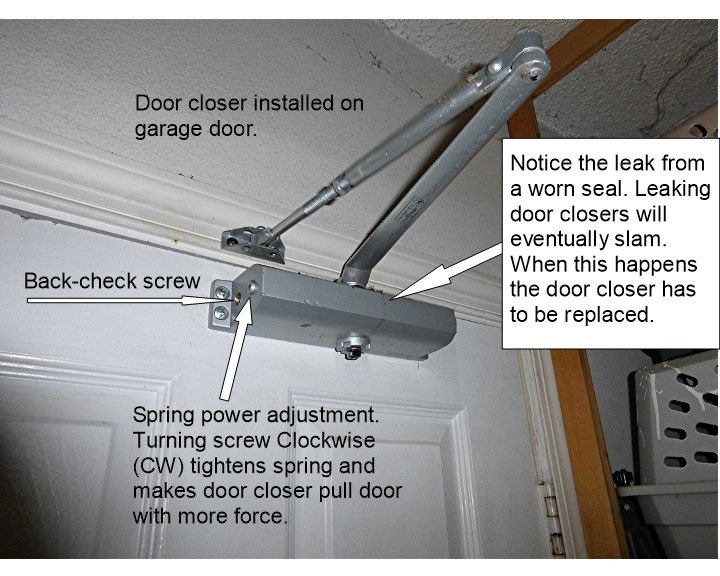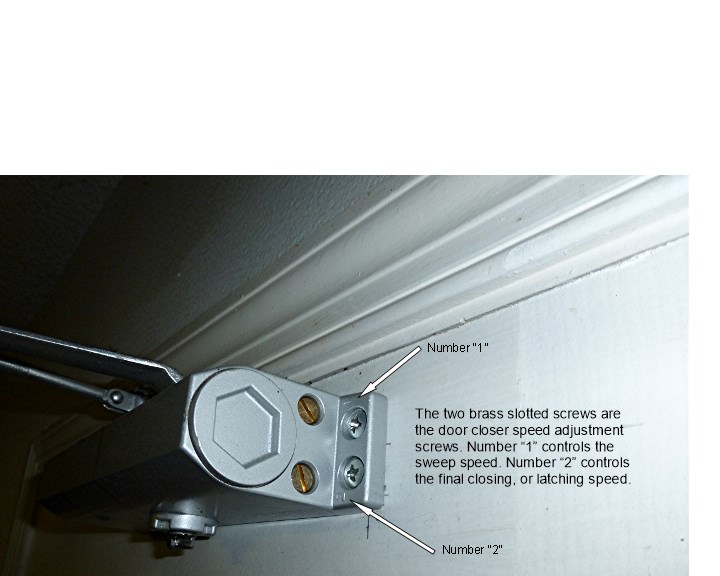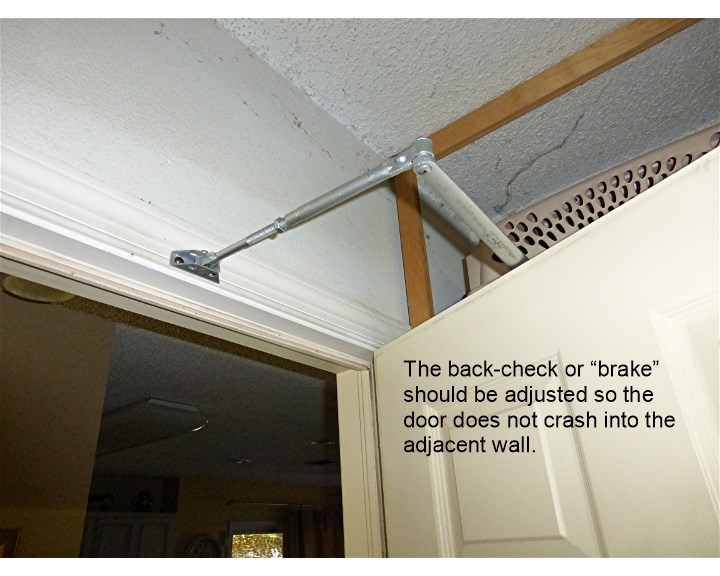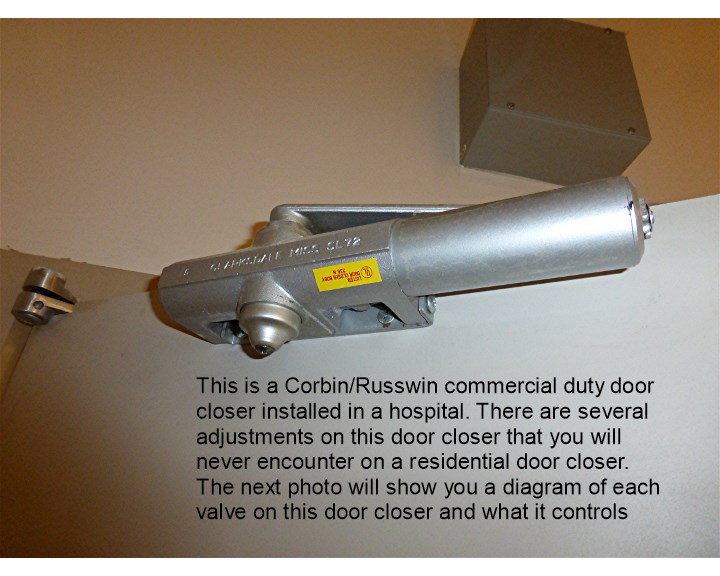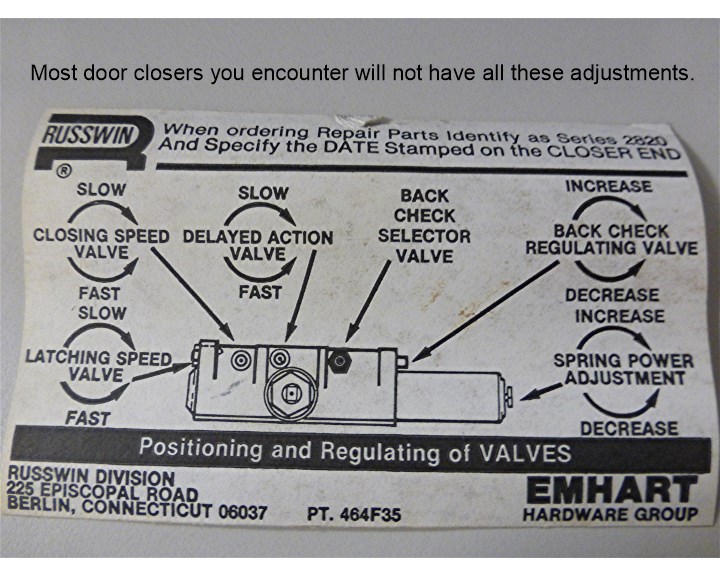Recently I worked at two homes where the front doors had a door closer installed to meet a life safety ordinance. The door closer insures the front door will close and prevent a draft that might help a smoldering fire rage out of control. Door closers are usually spring driven devices mounted at the top of a door. The device is filled with hydraulic fluid and the closing speed is adjusted with valves which allow the hydraulic fluid to move between chambers in the device.
Many times the garage door on a home will have spring loaded hinges. These hinges are considered door closers and insure the garage door will not be left open, allowing a draft to move through a room where combustible liquids are stored.
As I was working in these two homes repairing locks, I let go of the front door after entering the home and I was startled by a “SLAMM!” I asked the home owner if the slamming door bothered them, it certainly bothered me! “Oh, yes,” would be the reply, “but we don’t know how to make the door close slower. The door has always closed like that since we lived here X number of months or years.”
Spring loaded hinges have very little adjustments. A Door closer however, has at least two valves for controlling how fast the door will close. Some door closers have four or more adjustments that will control the door opening and closing. I will cover the adjustments you are most likely to encounter.
The first and simplest adjustment is “power.” Spring loaded hinges allow the installer to adjust how hard the door will close with a locking pin. When the door is closed, a special spanner wrench is used to tighten the spring. The spring is locked in place with a locking pin. If the hinge is never adjusted these pins can fall out and become lost. A spring hinge without a locking pin is just a hinge, nothing more. The point is, the spring controls the power, or how much force is applied to the door to close and latch the door.
The next adjustment on a door closer is the “sweep speed.” The sweep speed of the door covers fully open to about six inches from fully closed. Many times door closers have two valves numbered “1” and “2.” Number “1” is the sweep speed, turning the valve clockwise (CW) will slow the door down. The valve may require a regular screw driver or a hex key (sizes of hex keys vary between manufacturers). Turning the valve counter-clockwise (CCW) will open the valve and increase door speed. NEVER REMOVE THE VALVE from the door closer. If you do hydraulic fluid will pour out all over the door and your clothes. Sometimes the sweep speed and latching speeds are controlled with the same valve. These are usually on very cheap commercial door closers. I will not take the time to explain this complicated valve and how to adjust it here.
The number “2” valve on the door closer is the latching speed which controls the last six inches of the door fully closing and latching. You would adjust this valve the same as the sweep speed valve. The door from fully open to fully closed should take about seven seconds. Normally the door closes pretty quick until the last six inches. The six inches before fully closed should be controlled and slow to prevent little fingers from becoming trapped and possibly crushed.
Slamming doors can cause injury. Slamming doors will always vibrate hardware screws loose, usually the hinge screws. Loose screws can prevent doors from operating smoothly. The door may need to be pulled or pushed very hard to open. The locking hardware may be loose and very close to falling off the door. I recently heard one story where the door closer arm fell off the door and hit a customer in the head, ouch!
Ignorance of how a door should operate can lead to injury and a breach in security. Don’t ignore the warning signs and think the door has always worked this way, or the door will correct itself as it wears a groove into the threshold. Doors that are hard to open, close, lock or unlock should be checked out before a bigger problem arises.
The fourth adjustment on a better quality door closer is the back-check. Remember back to your grammar school days, when the clock would hit dismissal time, or the bell would ring for last period and the throng of youngsters would push the school doors open with a thrust of abandon? Did you ever wonder why the doors did not bounce off the walls and injure kids or damage the doors? The reason is the back-check. There is a valve in the door closer which takes over when the door is opening and gets to about 100 degrees. The back-check valve works like a brake and when properly adjusted brings the door to a cushy stop.
The fifth adjustment is a delayed-closing speed for handicapped openings. You will NOT encounter this adjustment on your home door closer. There are other mechanical adjustments which have to do with the closer arm and specific installation locations which deal with how far the door will swing, for example, 90 degrees as opposed to 180 degrees. Other considerations deal with the door opening out or opening in.
Your main concern is a slamming door. Your best option is to call a professional locksmith who has experience installing and adjusting door closers. If you are in Palm Beach County, Florida your best choice is Gater’s Locksmith, Inc. If you live anywhere else you can find a competent locksmith at: www.findalocksmith.com
Another good source for finding a locksmith in your area is: www.clearstar.com

